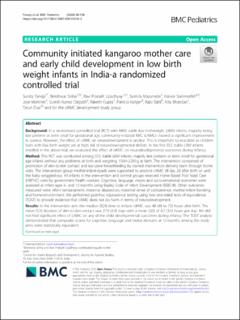| dc.contributor.author | Taneja, Sunita | |
| dc.contributor.author | Sinha, Bireshwar | |
| dc.contributor.author | Upadhyay, Ravi Prakash | |
| dc.contributor.author | Mazumder, Sarmila | |
| dc.contributor.author | Sommerfelt, Halvor | |
| dc.contributor.author | Martines, Jose Carlos | |
| dc.contributor.author | Dalpath, Suresh Kumar | |
| dc.contributor.author | Gupta, Rakesh | |
| dc.contributor.author | Kariger, Patricia | |
| dc.contributor.author | Bahl, Rajiv | |
| dc.contributor.author | Bhandari, Nita | |
| dc.contributor.author | Dua, Tarun | |
| dc.contributor.author | Abbasi, Farah | |
| dc.contributor.author | Panwar, Vaishali | |
| dc.contributor.author | Nagpal, Sugandhi | |
| dc.contributor.author | Shekhar, Medha | |
| dc.contributor.author | Ghosh, Runa | |
| dc.contributor.author | Kaur, Jasmine | |
| dc.contributor.author | Dube, Brinda | |
| dc.date.accessioned | 2021-07-07T09:15:54Z | |
| dc.date.available | 2021-07-07T09:15:54Z | |
| dc.date.created | 2020-05-12T17:05:21Z | |
| dc.date.issued | 2020 | |
| dc.Published | BMC Pediatrics. 2020, 20 (1), 1-12. | |
| dc.identifier.issn | 1471-2431 | |
| dc.identifier.uri | https://hdl.handle.net/11250/2763692 | |
| dc.description.abstract | Background: In a randomized controlled trial (RCT) with 8402 stable low birthweight (LBW) infants, majority being late preterm or term small for gestational age, community-initiated KMC (ciKMC) showed a significant improvement in survival. However, the effect of ciKMC on neurodevelopment is unclear. This is important to elucidate as children born with low birth weight are at high risk of neurodevelopmental deficits. In the first 552 stable LBW infants enrolled in the above trial, we evaluated the effect of ciKMC on neurodevelopmental outcomes during infancy.
Method: This RCT was conducted among 552 stable LBW infants, majorly late preterm or term small for gestational age infants without any problems at birth and weighing 1500–2250 g at birth. The intervention comprised of promotion of skin-to-skin contact and exclusive breastfeeding by trained intervention delivery team through home visits. The intervention group mother-infant-dyads were supported to practice ciKMC till day 28 after birth or until the baby wriggled-out. All infants in the intervention and control groups received Home Based Post Natal Care (HBPNC) visits by government health workers. Cognitive, language, motor and socio-emotional outcomes were assessed at infant-ages 6- and 12-months using Bayley Scale of Infant Development (BSID-III). Other outcomes measured were infant temperament, maternal depression, maternal sense of competence, mother-infant bonding and home-environment. We performed post-hoc equivalence testing using two one-sided tests of equivalence (TOST) to provide evidence that ciKMC does not do harm in terms of neurodevelopment.
Results: In the intervention arm, the median (IQR) time to initiate ciKMC was 48 (48 to 72) hours after birth. The mean (SD) duration of skin-to-skin-contact was 27.9 (3.9) days with a mean (SD) of 8.7 (3.5) hours per day. We did not find significant effect of ciKMC on any of the child developmental outcomes during infancy. The TOST analysis demonstrated that composite scores for cognitive, language and motor domains at 12 months among the study arms were statistically equivalent.
Conclusion: Our study was unable to capture any effect of ciKMC on neurodevelopment during infancy in this sample of stable late preterm or term small for gestational age infants. Long term follow-up may provide meaningful insights. | en_US |
| dc.language.iso | eng | en_US |
| dc.publisher | BioMed Central | en_US |
| dc.rights | Navngivelse 4.0 Internasjonal | * |
| dc.rights.uri | http://creativecommons.org/licenses/by/4.0/deed.no | * |
| dc.title | Community initiated kangaroo mother care and early child development in low birth weight infants in India - a randomized controlled trial | en_US |
| dc.type | Journal article | en_US |
| dc.type | Peer reviewed | en_US |
| dc.description.version | publishedVersion | en_US |
| dc.rights.holder | Copyright the authors | en_US |
| dc.source.articlenumber | 150 | en_US |
| cristin.ispublished | true | |
| cristin.fulltext | original | |
| cristin.qualitycode | 1 | |
| dc.identifier.doi | 10.1186/s12887-020-02046-4 | |
| dc.identifier.cristin | 1810612 | |
| dc.source.journal | BMC Pediatrics | en_US |
| dc.source.40 | 20 | |
| dc.source.14 | 1 | |
| dc.identifier.citation | BMC Pediatrics. 2020, 20, 150. | en_US |
| dc.source.volume | 20 | en_US |

